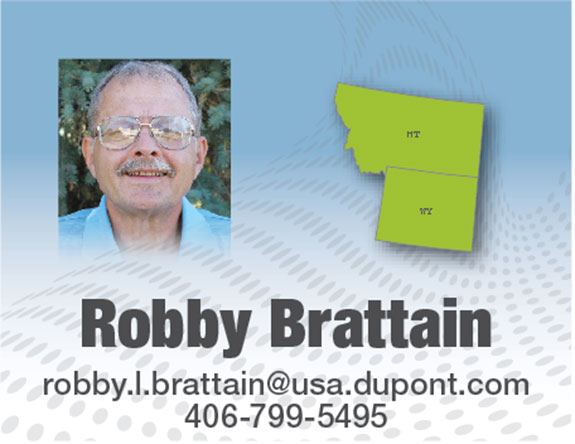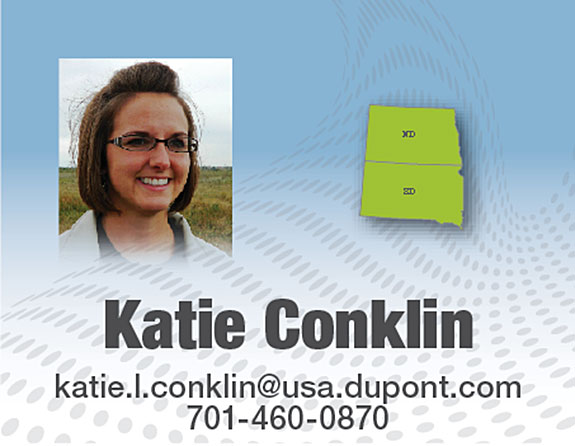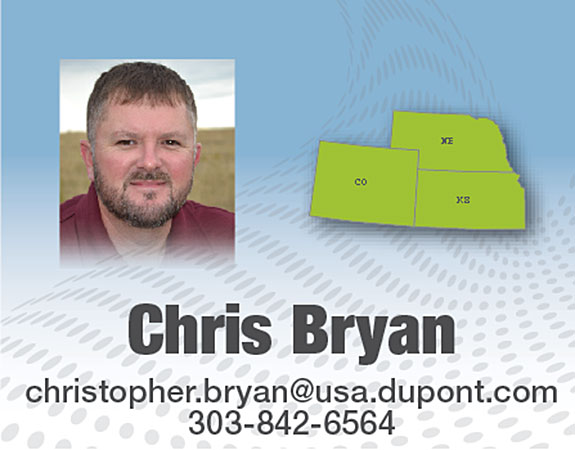Weed control generally is more effective on perennial plants later in the season as they move carbohydrates to roots for winter storage. “When applied in fall, herbicides can be readily transported to the roots of perennial plants,” explains Matt McGowin, DuPont crop protection range and pasture specialist for Louisiana, Mississippi, Arkansas, Tennessee, Kentucky and Alabama from the Southern Region.
Katie Conklin, DuPont crop protection range and pasture specialist for North Dakota and South Dakota from the Northern Region.
Gerald (G.W.) Hobson, DuPont crop protection range and pasture specialist for West Texas, southwestern Oklahoma and New Mexico from the West Region. “Take time to scout and identify weeds so you can choose the best herbicide for the job.”
Range and pasture specialists offer region-specific strategies for improving pasture and rangeland acres this fall.

Florida, Georgia, South Carolina, North Carolina and southern Virginia
Many bermudagrass fields are still struggling to recover from last year’s winterkill and winter stress. The impact of severe cold temperatures in January was worse than expected, and last spring we saw 30 to 75 percent stand reductions. Those fields will continue to need careful management, including weed control and fertilization.
Where grasses died, weeds can move in quickly, so consider a late fall or early winter herbicide application to prevent winter annuals from gaining a foothold.
Target henbit, Carolina geranium, Italian ryegrass and red sorrel. Follow the application with soil tests and necessary crop nutrition additions so grasses have what they need for fast spring growth. Pay close attention to soil pH, too. Annual soil tests are necessary for optimum grass production.
To control invasive grasses in bermudagrass – especially crabgrass, johnsongrass and bahiagrass – make an herbicide application after the last cutting to help reduce spring weed populations.
We’ve been testing January herbicide applications, and that timing appears to provide big benefits in early season weed control, allowing grasses to come out of dormancy with less weed competition. The result is a first cutting with better quality and good tonnage.

Louisiana, Mississippi, Arkansas, Tennessee, Kentucky and Alabama
Smutgrass has become a major weed threat in coastal region bermudagrass and bahiagrass pastures. Take action before weed densities increase. A well-timed herbicide application with rainfall and incorporation can be very effective in controlling smutgrass.
Other perennial grasses, including johnsongrass and vaseygrass, can also be controlled in fall.
Now is also a good time to control brush species, including green ash, honey locust and sweetgum, since herbicides are translocated to roots as plants prepare for dormancy.
Fall armyworms feed on forage crops and can persist through October, so it’s worth your time to scout pastures into the fall, especially after rain showers. If moth or worm counts are above thresholds, an insect control treatment may be economical for preserving the last hay cutting.
This year’s harsh winter temperatures and wet spring led to winterkill in some annual grasses. Growers who used a residual pre-emergence herbicide in spring saw less weed competition into summer. With fertilization, compromised grass populations have started to come back.

East Texas and Oklahoma
This season brought heavy weed pressures from the start, with more winter weed problems than many of us have seen in a long time, and grass stands took a hit. Then spring rains helped rye, cheatgrass, little barley and other undesirable grasses sprout. If you weren’t able to control weeds in the spring, the fall months are your next-best opportunity.
This is a good time to scout for evidence of winter grass weed populations, so you can make an herbicide application now or later in the winter. For weed escapes in grass pastures, your herbicide options are limited.
Herbicide options for suppression of King Ranch bluestem are also limited. A well-timed application after you’ve cut hay or rotated cattle off the pasture can control summer annual and perennial weeds.
Control thistles, including musk, yellow-spined, Texas and bull thistles, while they’re at the rosette stage. An herbicide with both contact and residual control also delivers good root absorption in woody species such as huisache and dewberry. For best control of dewberry, apply herbicide before berries have set and while the plant is in the vegetative stage.
Mowing and burning can’t control Sericea lespedeza, so apply a good herbicide while plants are blooming.
After the drought conditions we’ve endured, fall soil testing is important to determine what nutrients are needed to achieve desired grass production. Make sure stands have enough potassium for strong root development so desirable grasses can outcompete weeds as pasture and rangeland acres recover.

Montana and Wyoming
Now that moisture has returned to much of the region, both grasses and weeds are bouncing back. To prevent weeds from getting the upper hand, scout pastures and rangeland this fall and implement weed control where necessary.
Several alyssum species are becoming more of a problem in our region, including yellow, desert and hoary alyssum, which is toxic to horses. They’re very aggressive and can reduce tonnage from alfalfa fields and grass production of rangeland if left unchecked. A fall herbicide application with residual activity provides control through spring green-up.
Another weed that continues to spread is hoary cress (whitetop). A fall or spring application of a sulfonylurea herbicide is the best control option. If time allows this fall, I recommend controlling hoary cress this year.
Russian knapweed, toadflax, thistles and poisonous houndstongue also can be controlled in the fall. A foliar herbicide that provides residual control is your best option.
Next season’s alfalfa production will be better if you control grasses and broadleaf weeds this fall. Choose an herbicide that provides good residual activity to control winter annuals so your first cutting in 2015 will be weed-free.

North Dakota and South Dakota
If the condensed spring season prevented weed control in pastures in early 2014, then taking action this fall will be critical. Noxious weeds, including leafy spurge, absinthe wormwood and Canada thistle, are annual challenges but could merit extra attention this fall.
Absinthe wormwood usually invades areas where cattle congregate and, just like leafy spurge, is easier to control before it gets a foothold.
The best time to control musk and Canada thistles is after the first light frost and before a killing frost. Herbicide absorption and translocation is best when application is made while thistles are in the rosette stage.
Hoary cress (whitetop or whitecap) has become more prevalent in the western Dakotas and can spread quickly since it is a prolific seed producer. Good control of this creeping perennial can be achieved in spring or fall using a high rate of a sulfonylurea herbicide, which university trials have shown to be more effective than plant growth regulators.
Houndstongue is another weed making inroads in Dakota pastures. Because it is poisonous, early identification and control is important. This biennial weed forms a rosette the first year of growth and produces seeds the second year, so control houndstongue at the rosette stage and before a hard frost.
In some areas, eastern red cedar has begun to move from shelterbelts into pastures. It can outcompete grasses due to its fibrous root system and shade from older trees. Eastern red cedar foliage also can change soil pH, which inhibits grass growth. While large trees often need to be physically removed, spot spraying a soil-applied herbicide is an efficient way to control spread of young cedar trees.

Nebraska, Kansas and Colorado
With the welcome rains, broom snakeweed has appeared in more places throughout eastern Colorado and western Kansas and Nebraska, and Russian knapweed is becoming a bigger problem. Both weeds can be effectively controlled in the fall. Broom snakeweed usually blooms in the fall and needs to be sprayed while it’s still green.
Russian knapweed can be controlled even after the first freeze with a residual herbicide application. Herbicide uptake is best when plants are still green, but good control has been achieved with an application made even after Russian knapweed has begun to die back.
Now through October is a good time to control thistles, including musk and Canada thistles, while they are in the rosette stage. Sericea lespedeza, which was added to Nebraska’s noxious weed list last year, is best controlled with an herbicide application after flowering, since mechanical methods usually don’t work.
Continued good cattle prices should support investment in weed control this fall so pastures are ready for spring green-up and better production next season.

West Texas, southwestern Oklahoma and New Mexico
In our region, producing a grass crop is all about managing moisture. Welcome rains this year have helped pastures and rangeland begin to recover but also allowed weeds to come on strong. It’s critical to control weeds that compete with desirable grasses for moisture.
Broom snakeweed and other poisonous plants have spread this season and can be controlled in the fall before they go to seed. Now is also a good time to scout for and treat encroaching brush and weeds along fencerows.
In central and southern Texas, aggressive King Ranch bluestem has become a serious competitor in bermudagrass pastures. Herbicide options for suppression of King Ranch bluestem are limited, but a summer followed by fall application can be effective at releasing bermudagrass pastures from this competitive pressure.
For grass pastures, fall armyworm populations can be a concern into October, so continue to scout for the brown moths and young larvae, especially after rain showers. If moth or worm counts are above thresholds, treatment with an insect control product could be an economical option to help preserve grass tonnage and quality.
Late fall into early winter is a good time to test soils and apply necessary phosphate and potash to bermudagrass pastures to prepare stands to make the most of next season’s early spring growth.

Washington, Oregon, Idaho, Utah and Nevada
Fall is a good time to control whitetop, perennial pepperweed and other noxious weeds that have spread through pastures and rangeland during recent dry years. Both are hardy broadleaf weeds and members of the mustard family that can be effectively controlled with a fall herbicide applied before freeze-up using a foliar herbicide that provides residual control.
Be sure to scout for brush along fence lines and noxious weeds in planned feeding areas. Applying a broad-spectrum herbicide now can provide effective control of brush species, as well as thistles in the rosette stage.
Grasses and broadleaf weeds in alfalfa fields also can also be controlled with a fall herbicide application. Choose an herbicide that provides lasting residual activity to control winter annuals so your first cutting in 2015 will be weed-free. ![]()






